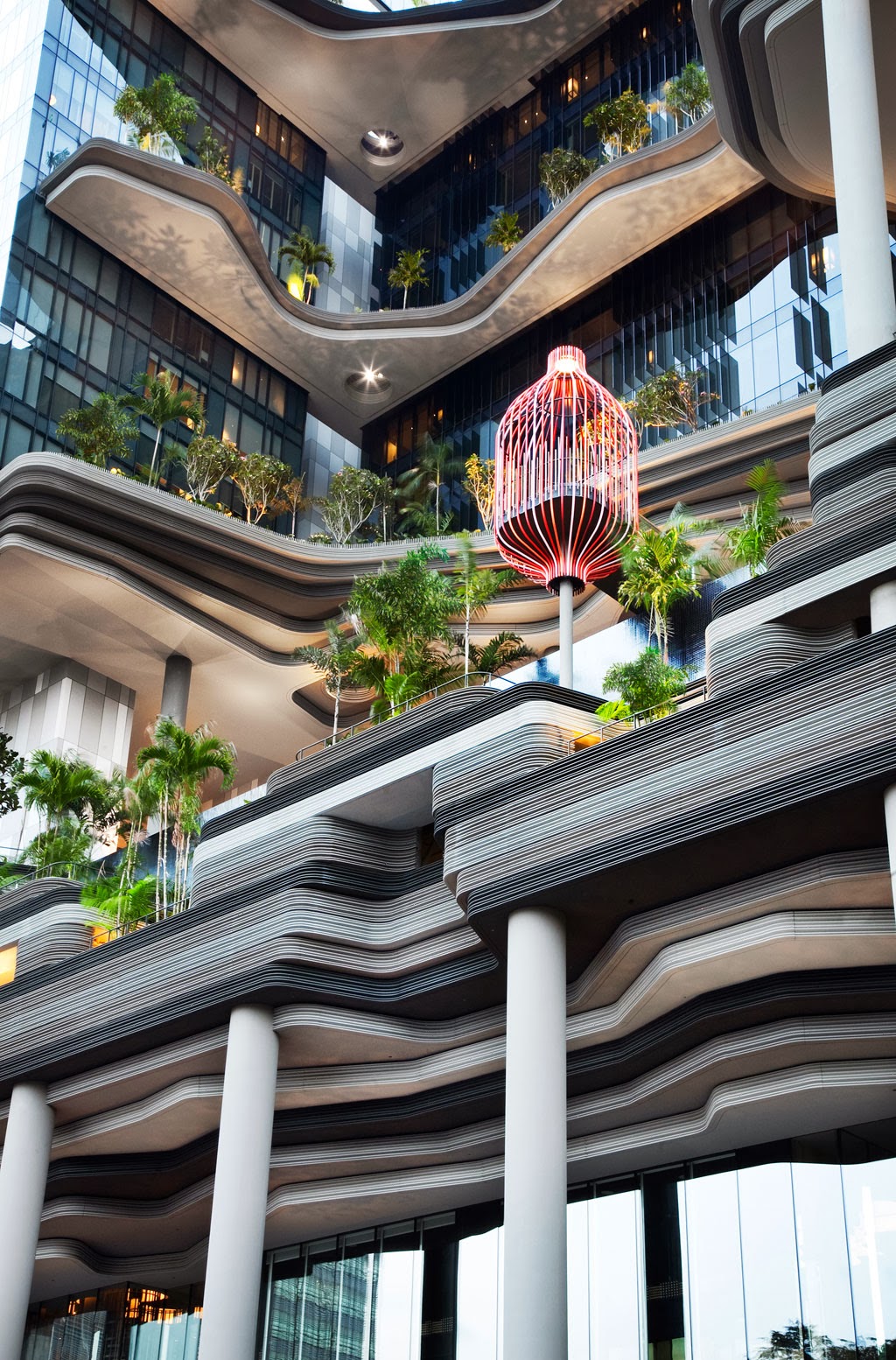Sunday 2 February 2014
Saturday 1 February 2014
Amazing Sky Gardens Hotel in Singapore
This hotel is designed by WOHA Architects the Parkroyal on
Pickering Hotel in Singapore. This hotel has unique features of six amazing sky
gardens that are cantilevered at every fourth level between the blocks of guest
rooms. Actually Parkroyal on Pickering is a hotel-in-a-garden idea that
incorporates energy saving features throughout the property including the
‘zero-energy’ sky gardens. The sustainable project design and green energies
have earned the hotel the BCA Green Mark Platinum, Singapore’s highest green
rating, as well as the Solar Pioneer Award for its advanced solar energy
system. The hotel newly celebrated its Ist year anniversary, and in that time
the hotel has won over twelve prestigious awards for its architecture and
sustainability, including: The President’s Design Award, “Best Hotel
Architectural Design” title at the South East Asia Property Awards, FIABCI
Singapore Property Award in the Hotel category and the 2013 HICAP Sustainable
Hotel Award. The property was also named “Hotel of the Year” at the World
Architecture News Awards. The 367 rooms hotel estimated project cost is $350
million to build and features 15,000 square meters of cascading greenery, dazzling
pools, planter walls, waterfalls, and four story high solar powered sky
gardens, constituting more than twice its land area.
Greater Bird of Paradise
The Paradisaea apoda (Greater
Bird-of-paradise) named by Carolus Linnaeus actually called is a
Bird-of-paradise in the genus Paradisaea. Paradisaea apoda, or "legless
bird-of-paradise", since early trade-skins to reach Europe were prepared
without feet by natives; this led to the misconception that these birds were
beautiful visitors from paradise that were kept aloft by their plumes and never
touched the earth until death. The bird of paradise is closely related to the
bowerbird and crow as spaniards in the 16th century coined the name bird of
paradise when glorious bird skins were brought to Europe aboard Magellan's
ship, Victoria.
The species is the largest member
in the genus Paradisae. The male species measuring up to 17 inches excluding
the long twin tail wires. The female is smaller, at only 14 inches. They have
robust feet adapted for perching, and bills of numerous shapes. The trailing
plumes, short velvet-like feathers and lovely collars are used by the male in
their courtship dance. The females, in contrast, are very plain. The males have
established territories where they dance for the females. The dances are as
amazing as the birds. Perched on a branch, the birds sway and crouch or stand
erect, tilt forward and backward, some even hang upside down. Each species has
its own type of dance. The plumage of this species is also sexually dimorphic.
The male has an iridescent green
face and a yellow glossed with silver iridescence crown, head and nape. The
rest of the body plumage is maroon-brown. The flank plumes are yellow at the
base, turning white and streaked with maroon. The female species has unbarred
maroon brown plumage. In both sexes the iris is commonly yellow and the bills
blue. Actually these are medium sized birds, maybe crow-sized, and are extraordinarily
beautiful. Birds of paradise mainly live in forests and frequent the high
treetops or lower scrub. The open nest is built in tree branches and sometimes
in holes
The Greater Bird of paradise is found
in Indonesia, to lowland and hill forests of southwest New Guinea and Aru
Islands. Bird of Paradise diet is consists mostly of insects, fruits, and seeds.
Moreover; a lesser population was introduced by Sir William Ingram in 1909-1912
to Little Tobago Island of West Indies in an effort to save the beautiful species
from extinction due to overhunting for plume trades. The introduced populations
survived until at least 1966 but most likely are extinct now, and are evaluated
as Least Concern on the IUCN Red List of Threatened Species.
Canadian Photographer Takes Silhouetted Selfies in Spectacular Landscapes
Paul Zizka a photographer belongs to Alberta Canada, has started on a new way to capture the really stunning natural environment that surrounds him in the Canadian Rockies. In its place of simply snapping shots of the environment, the photographer prepares his camera on its tripod, sets the timer, and quickly runs into the shot for a remarkable selfie. Distinct other typical selfies, often presenting low-quality pictures of someone with their extended arm holding onto the photographing device most probably with a phone. Paul Zizka snaps are first-rate images of man and nature. Paul shares the spotlight with the landscape, generally serving as a secondary subject himself to the majesty of the environment. His silhouette sits serenely below the Aurora Borealis, allowing its green and purple hues to hypnotize viewers. He says; I never get bored of shooting the aurora borealis, and a lot of my favorite self-portraits were taken during mainly intense northern lights displays. The aurora has an astonishing way to renew itself and show ever-different combinations of color and textures. I’m confidence that is through my photography people will revive the precious connection they can have with the wonders of our planet.
Subscribe to:
Posts (Atom)

























































